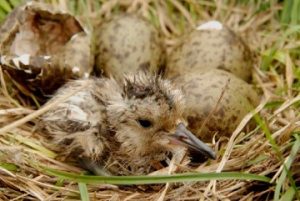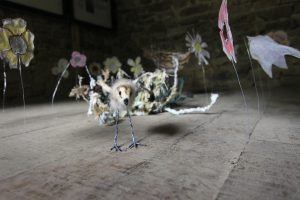
The Stiperstones and Corndon Hill Country Landscape Partnership Scheme (LPS) ended at Easter. Curlew Country was one of 14 active projects that formed part of the LPS, but which evolved and grew in ways that were not anticipated before the LPS began.
The LPS has received fresh funding for a new phase of the project and will continue with its work to save lowland curlew particularly in the focus area of the Shropshire Hills and Welsh Marches and research and trial interventions that will enable curlew population stability in the longer term.
Before the LPS started, during the consultation phase prior to application for funding, 97% of those consulted voted for a curlew recovery project.
Prior to the project good foundation work was carried out by local Community Wildlife Group volunteers, concentrating in part of the Shropshire curlew ‘hotspot’ area with the highest density of breeding pairs of curlew in Shropshire. Survey work carried out according to BTO methodology established the serious decline in adult population numbers in what is now the area in which Curlew Country operates. It was this group who pushed for a project to form part of the LPS. Their survey work continues and is enhanced by the two new Community Wildlife Groups created through another LPS project.
The design of the project that went into the LPS failed quickly. It was based on a traditional model of a project officer going out and briefing farmers on what to do in terms of habitat management to support curlew and assisting them to access agri-environment schemes. The farmers were very receptive to the idea of a project to help waders. They were however weary of people ‘telling them what to do’ as they saw it, said ‘why would I do anything for curlew when they will be predated anyway?’, ‘you conservationists need to get real about predation control, you are part of the problem, not the solution’. This led to a complete re-design of the project.
The new project plan was to work in close partnership with farmers and to closely monitor nests to discover what was causing nest failure in the Shropshire and Welsh Marches breeding curlew population of about 40 pairs of curlew within a 200km2 area. A Project Advisory Group was appointed to help oversee technical aspects of the project. The RSPB* drew up a nest monitoring brief and a field ornithologist was engaged to carry out the nest monitoring work.
The farmers living with the constant threat and reality of TB were convinced that the reason for failure in curlew nests would be badgers. Some local conservationists were concerned about the idea of predation control and some thought that habitat loss and management were the only reasons for nest failure. Two years of nest monitoring with cameras and thermacrons (data loggers) revealed that most nests were being predated at nest stage mainly by foxes and by badgers to a lesser extent. Chicks were monitored using radio tags. No chicks survived in Year 1 of the nest monitoring work. In Year 2 when only three nests with eggs remained they were fenced with temporary electric fencing using a design used by Natalie Meyer protecting curlew nests in Schleswig Holstein and recommended to Curlew Country by one of its national partners – The Game & Wildlife Conservation Trust. Following fencing of the three nests the eggs hatched, but all the chicks were subsequently lost and the radio tagging was largely unsuccessful as most chicks were taken out of range fairly quickly and presumed predated.

In year 3 (2017), interventions were introduced to try and enable greater breeding success. Temporary electric fences were erected around as many nests as possible and trial areas of predation control were introduced. Predation control was not possible across the whole LPS area as it can be costly and many grant makers will not fund this work or even fund a project where predation control is an element of the work. In this 3rd and final LPS year of the project, 30 chicks hatched from the nests monitored and between 1 and 3 survived to fledge successfully. When only three curlew family groups remained, the predation control contractors were all asked to focus on the areas in which they were feeding. Whilst the observations are not in any way scientific, it is likely that anecdotally that the fox control in these areas contributed to chick survival.
The use of temporary electric fencing was a first on the UK mainland. Another new initiative for UK curlew was the application of a licence to take and rear curlew eggs. The idea was that the eggs would be taken and replaced with eggs closer to hatching stage. At the end of the season we were left with six eggs, but with nowhere to return them to. Six chicks were reared and released at a migratory roost having been ringed and colour ringed.

The enthusiasm of the community getting involved with the Curlew Country project has been inspirational. Alongside the conservation volunteer work others have got involved with arts intiatives, including sculpture workshops, a curlew choir, writing workshops, a reminiscences project and various family arts projects. Help with money raising ideas has been generated form these inclusive events that raise awareness and inspire fresh ideas to help curlew.
Curlew Country’s farming partners cannot support curlews if their farm businesses are not also thriving. A farmers’ steering group has been formed to oversee curlew recovery work, discover what other wildlife there is on their farms and to form and implement a plan that provides sustainability for both wildlife and farming at landscape scale. There has been professional analysis of the real cost to farmers of supporting breeding curlew on their land and the findings are being handed on to policy makers at both a local and national level.
Back to Curlew Country Blog Posts

